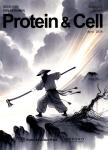Single-nucleus transcriptomic landscape of primate hippocampal aging
作者机构:State Key Laboratory of Membrane BiologyInstitute of ZoologyChinese Academy of SciencesBeijing 100101China State Key Laboratory of Stem Cell and Reproductive BiologyInstitute of ZoologyChinese Academy of SciencesBeijing 100101China Advanced Innovation Center for Human Brain ProtectionNational Clinical Research Center for Geriatric DisordersXuanwu Hospital Capital Medical UniversityBeijing 100053China CAS Key Laboratory of Genomic and Precision MedicineBeijing Institute of GenomicsChinese Academy of SciencesBeijing 100101China Institute for Stem Cell and RegenerationChinese Academy of SciencesBeijing 100101China University of Chinese Academy of SciencesBeijing 100049China China National Center for BioinformationBeijing 100101China Aging Translational Medicine CenterXuanwu HospitalCapital Medical UniversityBeijing 100053China Department of NeurosurgeryXuanwu HospitalCapital Medical UniversityBeijing 100053China SinoDanish CollegeUniversity of Chinese Academy of SciencesBeijing 101408China SinoDanish Center for Education and ResearchBeijing 101408China Department of Obstetrics and GynecologyCenter for Reproductive MedicinePeking University Third HospitalBeijing 100191China Beijing Institute for Stem Cell and Regenerative MedicineBeijing 100101China Stem Cell Research CenterPeking University Third HospitalBeijing 100191China Gene Expression LaboratorySalk Institute for Biological StudiesLa JollaCAUSA
出 版 物:《Protein & Cell》 (蛋白质与细胞(英文版))
年 卷 期:2021年第12卷第9期
页 面:695-716页
核心收录:
学科分类:0710[理学-生物学] 0831[工学-生物医学工程(可授工学、理学、医学学位)] 1007[医学-药学(可授医学、理学学位)] 1002[医学-临床医学] 07[理学] 0703[理学-化学] 0836[工学-生物工程] 071002[理学-动物学]
基 金:This work was supported by the National Key Research and Development Program of China(2020YFA0804000) the Strategic Priority Research Program of the Chinese Academy of Sciences(XDA16010000) the National Key Research and Development Program of China(2019YFA0110100,2020YFA0112201,2018 YFC2000100,2017YFA0103304,2017YFA0102802,2018Y FA0107203,2020YFA0803401,and 2019YFA0802202) the National Natural Science Foundation of China(Grant Nos.81921006,81625009,91749202,81861168034,91949209,92049304,81822018,82071588,92049116,31900523,32000500,31970597,82030037,and 81801534) the Program of the Beijing Municipal Science and Technology Commissi on(Z191100001519005) Beijing Natural Science Foundation(Z190019) the Key Research Program of the Chinese Academy of Sciences(KFZD-SW-221) K.C.Wong Education Foundation(GJTD-2019-06,GJTD-2019-08) the International Partnership Program of Chinese Academy of Sciences(152111KYSB20160004) the Non-profit Central Research Institute Fund of Chinese Academy of Medical Sciences(2020-JKCS-011) the State Key Laboratory of Stem Cell and Reproductive Biology,the State Key Laboratory of Membrane Biology,the Milky Way Research Foundation(MWRF),and the Moxie Foundation(for J.C.I.B.)
主 题:aging hippocampus primate single-cell RNA sequencing
摘 要:The hippocampus plays a crucial role in learning and memory,and its progressive deterioration with age is functionally linked to a variety of human neurodegenerative *** a systematic profiling of the aging effects on various hippocampal cell types in primates is still ***,we reported a variety of new aging-associated phenotypic changes of the primate *** include,in particular,increased DNA damage and heterochromatin erosion with time,alongside loss of proteostasis and elevated *** understand their cellular and molecular causes,we established the first single-nucleus transcriptomic atlas of primate hippocampal *** the 12 identified cell types,neural transiently amplifying progenitor cell(TAPC)and microglia were most affected by ***-depth dissection of gene-expression dynamics revealed impaired TAPC division and compromised neuronal function along the neurogenesis trajectory;additionally elevated pro-inflammatory responses in the aged microglia and oligodendrocyte,as well as dysregulated coagulation pathways in the aged endothelial cells may contribute to a hostile microenvironment for *** rich resource for understanding primate hippocampal aging may provide potential diagnostic biomarkers and therapeutic interventions against age-related neurodegenerative diseases.



